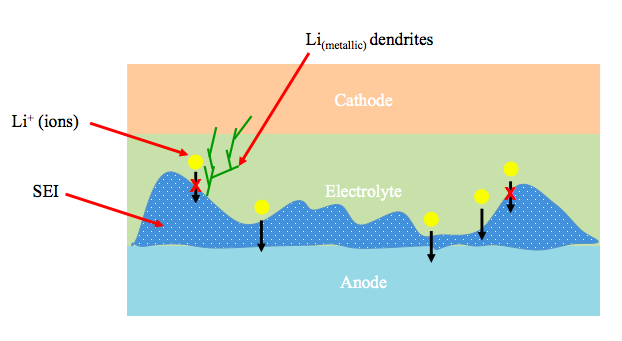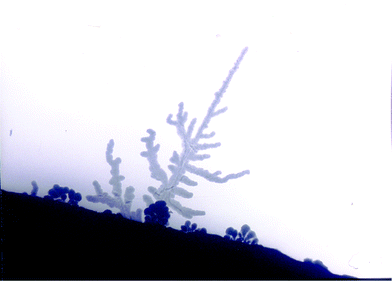Rechargeable lithium ion batteries have received some bad press over the past ten years due to malfunctioning units in laptops, cars and now airplanes. There are several reasons why a lithium ion battery might explode but I wanted to elaborate on the most common mechanism: lithium dendrite formation. Dendrite what? We’ll get to it…
In a previous post I quickly outlined the main functioning parts of a lithium ion battery. The anode is typically comprised of graphite and when a battery charges, lithium ions diffuse into that graphite. I also mentioned that there is an interface between that graphite anode and the electrolyte. That interface might look something like this:
When the energy (voltage) of the cell reaches a certain point, some of the liquid electrolyte can interact with the lithium ions and also the graphite surface to form a solid-electrolyte interface or SEI. This SEI is complex in nature and its composition can vary based on the way you charge and discharge a battery. SEI is a good thing and a bad thing. It’s good in that it forms a protecting layer that shields the graphite from further reactions occurring and when thin enough, allows lithium ions to travel back and forth. It can also be bad. If it gets too thick or is comprised of the wrong components due to a strange charging or discharging condition, it will not allow the flow of lithium ions in and out of the anode. When blocked flow occurs and further current is supplied to the battery (plugged in phone or laptop), the energy (voltage) of the cell decreases to a level where instead of lithium ions diffusing from electrolyte to anode being the most optimal reaction, lithium ions are reduced to lithium metal. The term reduced is used to describe the addition of an electron to an atom, ion or molecule – I know, counterintuitive. Conversely, oxidation describes the subtraction or taking away of an electron from an atom, ion or molecule. So now the energy is so low that this reaction is allowed:
When metallic lithium is formed at the interface between the electrolyte and the anode, it tends to crystallize and grow in a needle-like pattern that radiates away from a point. That point is called a nucleation site. In the biz, the growth of needle-like patterns of metallic lithium are referred to as “lithium dendrite formation.” This dendrite formation, if current is continually supplied to the cell, will continue to grow across the electrolyte until making contact with the opposite electrode, the cathode. Lithium metal conducts electricity reasonably well and thus we’ve created a short circuit condition. Short circuits tend to generate a lot of heat. Get things hot enough and you will ignite the liquid organic electrolyte (it’s a hydrocarbon-based liquid much like gasoline) and battery explosion is likely soon to follow.

“Bad” SEI does not allow the flow of lithium ions in and out of the anode due to both thickness issues as well as a different chemical makeup compared to good SEI. Dendritic growth of metallic lithium shorts the battery after reaching the cathode.

Actual lithium dendrites growing from an anode surface. Image from: R.R. Chianelli, J. Cryst. Growth, 1976, 34, 239-244.
So what do we do to prevent this? There are several options. The one currently in place is to create a computer program to control the charging when the battery is nearly 100% full. This means your battery will charge very quickly from 0% up to about 80-90% and then slows its rate of charge way down for the last 10-20% to lower the chance that this overcharge condition is achieved. More clever options in the future may involve non-liquid electrolytes. Lithium dendrites are quite brittle. Thus they would not be able to puncture through a solid electrolyte. These solid electrolytes are being developed. Another option would be to use non-flammable liquid electrolytes. Unfortunately no one has come up with one of these that has all the attributes required for industry – or at least the attributes they’ve been accustomed to having with current flammable electrolytes. There are other more complicated schemes being looked at to alleviate this problem but none seem anywhere near ready for application. I feel that the solid electrolyte is ultimately the way to go and would solve some major problems related to implementing high powered rechargeable batteries in electric vehicles.


